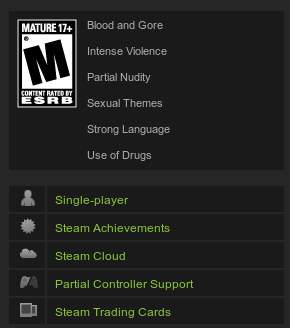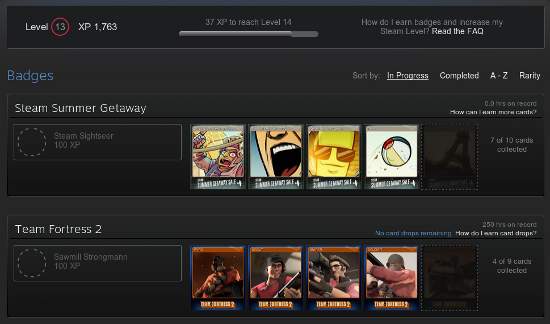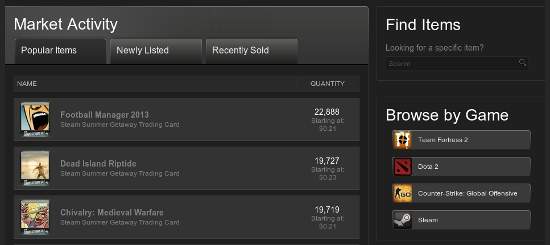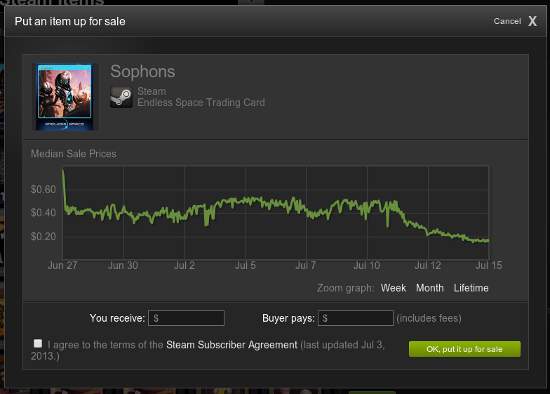Although they emerged from beta early in the summer of 2013, Steam Trading Cards really rose to prominence with the start of the 2013 Steam Summer Sale. A whole slew of games now drop Steam Trading Cards, and the sale itself really brought attention to them. However, it's not totally clear to most people what good these Steam Trading Cards are, even after reading Valve's FAQ. Thus, I'm going to attempt to demystify them and help you answer the question: Should I Care About Steam Trading Cards?
So, Should You Care?
Here's a quick quiz to determine if you care about Steam Trading Cards:
- Are you excited about cosmetic customization elements in games? For instance, do you spend a long time getting your character's face just right in Skyrim, or do you like picking out and wearing hats in Team Fortress 2?
- Do you find yourself comparing your Steam account to other people's? For instance, do you look at their achievements or their profile and say "I am SO much better than them!"
- Do you think a few dollars is worth a minimal effort? If I told you that you could potentially make ~$5 today in Steam Store credit through Steam Trading Cards, would you be excited?
If you answered "No!" to all three of these questions, congratulations! You can safely ignore Steam Trading Cards. You will probably end up with some as a result of playing games and participating in certain Steam events (like the 2013 Steam Summer Sale), but you can just safely leave them in your inventory and miss out on practically nothing. Who knows, maybe someday they'll be worth a lot of money!
If you answered "Yes!" to some or all of these questions, you should probably keep reading, so that you can understand how Steam Trading Cards can help you achieve these goals.
Getting Trading Cards
Steam Trading Cards "drop" from certain Steam games and events. In order to get a card "drop" you have to play a game that features Steam Trading Cards. You can see whether or not a game has Steam Trading Card support via the store page for the game:

All you have to do to get cards to drop is launch the game. You don't have to play, win, get achievements, or anything else. You can leave it at the main menu and go do something else. You can earn cards in your sleep!
There are also certain events (Steam Sales, etc) that drop cards. The rules for these cards are special, and they are typically documented as part of the event.
In addition to regular cards, there are rarer versions called "foil cards" - these are identical to the normal cards except that they are rare, and therefore might be somewhat more valuable if offered for sale. Functionally, they're exactly the same as normal cards, though.
There is a maximum amount of card drops per game, however. Usually this is around half the amount of cards you need to craft a badge. Active Steam users can sometimes qualify for a "Booster Pack" which is randomly awarded to you and will allow you to get some additional cards for the Booster Pack's game.
What's this "badge" I speak of, you say? How very forward-thinking of you! We're just about to cover that...
Badges and Other Cosmetic Benefits
So now you've got some cards. The primary purpose of collecting cards is to make badges. In order to craft a badge, you need a full set of unique Steam Trading Cards from the same game.
You can track your progress towards badges on your profile:

This handy screen also serves as a way to keep track of all the games you own which drop cards, as well as any active events (eg, the Steam Summer Sale 2013) which drop cards. It will also tell you if you have card drops for a game remaining.
As I noted in the previous section, you can only get around half the number of cards you need for a badge from a given game. Thus, you will need to buy or trade for cards to get a complete set. (More on buying, selling, and trading later!)
Once you have a complete set for a game or event, you can go to your badges screen and craft them into a badge.
Crafting a badge does several things for you:
- The badge is displayed on your Steam Profile, where others can see it (and you can feature it, if you want to show off)
- You get a random emoticon related to the game or event which you can use in chat and in other Steam-related text areas
- You get a random profile background related to the game or event that you can use to customize your Steam Profile
- You get some Steam Experience towards your Steam Level
The emoticon and profile background are also items that can be traded, bought, or sold. Some of these are also "rare" - like the foil cards.
While I'm on the topic of foil cards, there are also foil badges, which are crafted from foil cards. At this point, these are the same as normal badges, just shinier.
Badges have multiple levels, so even after you craft a badge you can still collect another set of the Steam Trading Cards for that same game and craft a badge again. You'll get more of everything I've listed above (emoticons, profile backgrounds, experience, etc) every time you level the badge up.
Steam Level is a brand new concept. You earn experience towards your Steam Level through many means, including the age of your account, owning games, crafting badges, participating in events, and so forth. Right now mostly the level serves as a gate to certain content (eg, you have to be level 5 to get cards from voting in the 2013 Steam Summer Sale, and each level expands your max friends list a bit) and for bragging rights. To that end, there are some badges you can get that are unrelated to Steam Trading Cards. We won't be covering those today, but do know that if you're just in it for the Steam Level there are other ways to get ahead.
Buying, Selling, and Trading Cards
Usually, you can't craft a game badge from Steam Trading Cards on your own. You're going to have to trade for or buy additional cards to augment your card drops. If you've got cards for a game you have no interest in, or duplicate cards (and you're not going to craft another badge level), you may wish to trade them away or sell them on the Steam Market.
The market is located under the "Community" menu on the Steam interface and website:

Here, you can search for and purchase cards, emoticons, and profile backgrounds, as well as in-game items for certain games like DOTA 2 and Team Fortress 2. Don't forget that you're paying real, actual money for these items! You'll need a credit card, some credit in your Steam account, or some other form of payment in order to buy.
You can also hit the "Sell an item" button to rid yourself of unwanted stuff:

Here you can see the historical prices for the item in question, and you can set the sale price for it. The Steam Trading Card economy is still in its infancy, so it's not unusual to see major spikes in the supply and demand of these items.
If you're just interested in profile backgrounds and/or emoticons, you may wish to buy them directly. Crafting a badge might give you one of these that you don't have, but it also might give you a dupe or one you're not interested in. Depending on the relative prices and your priorities, you may wish to consider buying or selling the "loot" from badge creation rather than the trading cards themselves.
The Economic Perspective
Steam Trading Cards are an interesting economic experiment on Valve's part. There are many people who go absolutely bonkers for cosmetic items in video games. In fact, some of the most premium luxury aspects of Team Fortress 2 revolved around the buying and selling of rare hats and accessories. Whether or not Steam Trading Cards catch fire still remains to be seen. At this point, there is an enormous amount of supply and not nearly as much demand.
However, we've seen that limited-time items tend to command high prices. Things like Team Fortress 2 Earbuds are considered very valuable, despite the fact that they were a free giveaway to those who tried Team Fortress 2 during the Mac beta period.
I'd be tempted to hang onto limited-time trading cards and related items, just to see what falls out as a major currency later on down the line. After all, I'm getting them essentially free at this point.
Selling trading cards at sub-$0.25 prices seems like a fool's game. There's not much of a way for the price of trading cards to go down from here, and there's no cost to hold on to them, so why not wait?